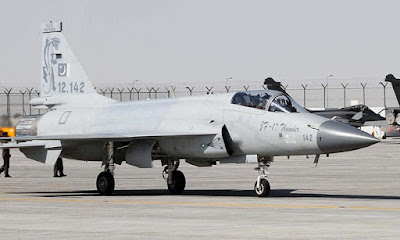 |
| Jf-17 Block 2 |
As a general point, the greatest value of the JF-17 (at least for Pakistan) does not rest in its performance, but in the reality that Pakistan has authority over the platform. By “authority” we refer to the fact that the Pakistan Air Force (PAF) can configure the JF-17 according to its will. This is the most essential point. While the F-16 is inherently the superior platform in terms of performance and quality, the PAF does not have the luxury to push the Viper to its available potential.
Just consider the fact that the PAF cannot readily integrate a high off-boresight (HOBS) air-to-air missile (AAM) onto its F-16s without U.S. approval of some shape or form. Even HOBS AAM that have been technically cleared for the F-16, such as the IRIS-T (developed by the German company Diehl BGT), cannot be configured onto the PAF’s F-16s without the U.S.’ approval. It would basically have to wait on America’s willingness to release the comparable AIM-9X; and this story is repetitive – the PAF’s F-16s have yet to be equipped with stand-off weapons (SOW), anti-ship missiles (AShM), and anti-radiation missiles (ARM).
On the other hand, despite the JF-17’s comparatively limited performance, the PAF has been able to arm the JF-17 with the C-802 AShM, and has the H-2/H-4 SOW and MAR-1 ARM in the pipeline (if not in the process of integration). And as we have repeatedly stated in earlier articles, it is the JF-17 that has a HOBS AAM, active electronically-scanned array (AESA) radar, infrared search and track (IRST), and air-launched cruise missile (ALCM) integration in the pipeline – not the PAF’s F-16s. What benefit does the F-16’s multi-role prowess offer the PAF when that prowess is gradually eroding in the face of the Indian Air Force (IAF) and Indian Navy (IN)’s impressive qualitative advancements?
Finally, there is the reality that unlike the F-16, the PAF benefits from an increasingly adept domestic base capable of thoroughly supporting the JF-17. Yes, Pakistan Aeronautical Complex (PAC) is a novice in terms of being an aerospace industry entity, but it is gradually and incrementally becoming capable, despite the difficult political and economic limitations Pakistan throws onto itself. The workshare agreement has shifted 58% of the JF-17’s airframe manufacturing to Kamra, and efforts are underway to bring a maintenance, repair and overhaul (MRO) for Klimov turbofans as well. With the maintenance and support channel being domestic, the PAF can draw upon the benefits of assured and affordable accessibility. The necessities produced in Pakistan (and in some cases imported from China and Russia) are at the affordable side of the cost-spectrum; the money that goes back into PAC also goes back into Pakistan.



